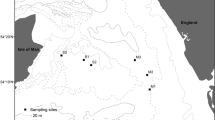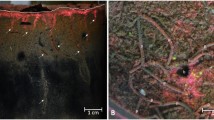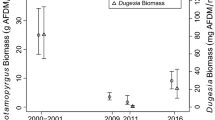Abstract
Negative connotations of invasive plants worldwide have implicated them as the bearers of unfavorable ecosystem change. We contrasted 5-yr-old and 20-yr-oldPhragmites populations with pre-invasion areas occupied byTypha spp. andPanicum virgatum in an oligohaline tidal marsh of Chesapeake Bay. Peak live biomass was 3 times greater, while standing dead and litter was twice as great in the 20-yr-oldPhragmites. It is this abundance of concentrated litter on the marsh surface of maturePhragmites populations that we implicate as encouraging the trapping of organic and mineral matter. The rate of vertical accretion in 20-yr-oldPhragmites populations is 3–4 mm yr−1 above the adjacent populations. By integrating the constant initial concentration and constant rate of supply models on individual210Pb cores, we estimate thatPhragmites populations require a minimum of 7-yr post-colonization to enhance rates of accretion in this system. In ligh of the considerable loss of marsh habitat from relative sea-level rise, this finding contests the view that invasion creates strictly undesirable change at the ecosystem level.
Similar content being viewed by others
Literature Cited
Appleby, P. G. andF. Oldfield. 1978. The calculation of lead-210 assuming a constant rate of supply of unsupported210Pb to the sediment.Catena 5:1–8.
Armstrong, J. andW. Armstrong. 1991. A convective through-flow of gases inPhragnites australis (Cav.) Trin. ex Steud.Aquatic Botany 39:75–88.
Ashton, P. J. andD. S. Mitchell. 1989. Aquatic plants: Patterns and modes of invasion, attributes of invading species and assessment of control programmes, p. 111–154.In J. A. Drake, H. A. Mooney, F. di Castri, R. H. Groves, F. J. Kruger, M. Rejmanek, and M. Williamson (eds.), Biological Invasions: A Global Perspective. John Wiley & Sons, New York.
Bryner, J. R. 2000. The effects of iron and sulfur on phosphorus dynamics along a tidal gradient in fresh/oligohaline marshes. Master's Thesis, University of Maryland at College Park, College Park, Maryland.
Chambers, R. M., L. A. Meyerson, andK. Saltonstall. 1999. Expansion ofPhragnites australis into tidal wetlands of North America.Aquatic Botany 64:261–273.
Church, J. A., J. M. Gregory, P. Huybrechts, M. Kuhn, K. Lambeck, M. T. Nhuan, D. Qin, andP. L. Woodworth. 2001. Changes in sea level, p. 639–694.In J. T. Houghton, Y. Ding, D. J. Griggs, M. Noguer, P. J. van der Linden, X. Dai, K. Maskell, and C. A. Johnson (eds.), Climate Change 2001: The Scientific Basis. Contribution of Working Group I to the Third Assessment Report of the Integovernmental Panel on Climate Change. Cambridge University Press, New York.
Coops, H. andG. van der Velde. 1996. Effects of waves on helophyte stands: Mechanical characteristics of stems ofPhragmites australis andScirpus lacustris.Aquatic Botany 53:175–185.
Fenwick, G. H. 1982. The Nature Conservancy Preseve Master Plan for Adkins Tract, Near Easton, Talbot County, Maryland. The Nature Conservancy, Annapolis, Maryland.
Flynn, W. W. 1968. The determination of low levels of polonium-210 in environmental materials.Analytica Chimica Acta 43: 221–227.
Frey, R. W. andP. B. Basan. 1978. Coastal salt marshes, p. 225–301.In R. A. Davis, Jr. (ed.), Coastal Sedimentary Environments, Springer-Verlag, New York.
Gordon, D. R. 1998. Effects of invasive, non-indigenous plant species on ecosystem processes: Lessons from Florida.Ecological Applications 8:975–989.
Graneli, W. 1989. Influence of standing litter on shoot production in reed,Phragmites australis (Cav.) Trin. ex Steudel.Aquatic Botany 35:99–109.
Hara, T., J. van der Toorn, andJ. H. Mook. 1993. Growth dynamics and size structure of shoots ofPhragmites australis, a clonal plant.Journal of Ecology 81:47–60.
Haslam, S. M. 1969. Stem types ofPhragmites communis Trin.Annals of Botany 33:127–131.
Haslam, S. M. 1971a. Community regulation inPhragmites communis Trin. I. Monodominant stands.Journal of Ecology 59:65–73.
Haslam, S. M. 1971b. The development and establishment of young plants ofPhragmites communis Trin.Annals of Botany 35: 1059–1072.
Haslam, S. M. 1973. Some aspects of the life history and autecology ofPhragmites communis Trin. A review.Polskie Archiwum Hydrobiologii 20:79–100.
Herbst, M. andL. Kappen. 1999. The ratio of transpiration versus evaporation in a reed belt as influenced by weather conditions.Aquatic Botany 63:113–125.
Jowsey, P. C. 1996. An improved peat sampler.New Phytologist 65:245–248.
Kearney, M. S., A. S. Rogers, J. R. G. Townshend, E. Rizzo, D. Stutzer, J. C. Stevenson, andK. Sundberg. 2002. Landsat imagery shows decline of coastal marshes in Chesapeake and Delaware Bays.EOS 83:173, 177–178.
Kudo, G. andK. Ito. 1988. Rhizome development ofPhragmites australis in a reed community.Ecological Research 3:239–252.
Lissner, J. andH.-H. Schierup. 1997. Effects of salinity on the growth ofPhragnites australis.Aquatic Botany 55:247–260.
Marks, M., B. Lapin, andJ. Randall. 1994.Phragmites australis (P. communis): Threats, management, and monitoring.Natural Areas Journal 14:285–294.
Merrill, J. Z. 2000. Tidal freshwater marshes as nutrient sinks: Particulate nutrient burial and denitrification. Ph.D. Dissertation, University of Maryland at College Park, College Park, Maryland.
Meyerson, L. A., R. M. Chambers, andK. A. Vogt. 1999. The effects ofPhragmites removal on nutrient pools in a freshwater tidal marsh ecosystem.Biological Invasions 1:129–136.
Meyerson, L. A., K. Saltonstall, L. Windham, E. Kiviat, andS. Findlay. 2000. A comparison ofPhragmites australis in freshwater and brackish marsh environments in North America.Wetlands Ecology and Management 8:89–103.
Odum, W. E. 1988. Comparative ecology of tidal freshwater and salt marshes.Annual Review of Ecology and Systematics 19:147–176.
Randall, J. M. 1997. Defining weeds of natural areas, p. 18–25.In J. O. Luken and J. W. Thieret (eds.), Assessment and Management of Plant Invasions. Springer-Verlag, New York.
Reed, D. J. 1995. The response of coastal marshes to sea-level rise: Survival or submergence?Earth Surface Processes and Land-forms 20:39–48.
Rejmanek, M., C. E. Sasser, andG. W. Peterson. 1988. Hurricane-induced sediment deposition in a Gulf coast marsh.Estuarine, Coastal and Shelf Science 27:217–222.
Rice, D., J. E. Rooth, andJ. C. Stevenson. 2000. Colonization and expansion ofPhragmites australis in upper Chesapeake Bay tidal marshes.Wetlands 20:280–299.
Robbins, J. A. 1978. Geochemical and geophysical applications of radioactive lead, p. 285–405.In J. O. Nriagu (ed.), The Biogeochemistry of Lead in the Environment. Elsevier, Amsterdam, The Netherlands.
Rooth, J. E. andJ. C. Stevenson. 2000. Sediment deposition patterns inPhragmites australis communities: Implications for coastal areas threatened by rising sea-level.Wetlands Ecology and Management 8:173–183.
Rooth, J. E. andL. Windham. 2000.Phragmites on death row: Is biocontrol really warranted?Wetland Journal 12:29–37.
Ruesink, J. L., I. M. Parker, M. J. Groom, andP. M. Kareiva. 1995. Reducing the risks of nonindigenous species introductions.Bioscience 45:465–477.
Staver, L. W., K. W. Staver, andJ. C. Stevenson. 1996. Nutrient inputs to the Choptank River estuary: Implications for watershed management.Estuaries 19:342–358.
Stevenson, J. C., J. E. Rooth, M. S. Kearney, andK. L. Sundberg. 2000. The health and long term stability of natural and restored marshes in Chesapeake Bay, p. 709–735.In M. P. Weinstein and D. A. Kreeger (eds.), Concepts and Controversies in Tidal Marsh Ecology. Kluwer, Boston, Massachusetts.
Stevenson, J. C., L. W. Staver, andK. W. Staver. 1993. Water quality associated with survival of submersed aquatic vegetation along an estuarine gradient.Estuaries 16:346–361.
Stumpf, R. P. 1983. The process of sedimentation on the surface of a salt marsh.Estuarine, Coastal and Shelf Science 17:495–508.
Sugai, S. F. 1990. Transport and sediment accumulation of210Pb and157Cs in two southeast Alaska fjords.Estuaries 13:380–392.
Talley, T. S. andL. A. Levin. 2001. Modification of sediments and macrofauna by an invasive marsh plant.Biological Invasions 3:51–68.
Turner, L. J. andL. D. Delorme. 1996. Assessment of210Pb data from Canadian lakes using the CIC and CRS models.Environmental Geology 28:78–87.
Vitousek, P. M. 1986. Biological invasions and ecosystem properties: Can species make a difference, p. 163–176.In H. A. Mooney and J. A. Drake (eds.), Ecology of Biological Invasions of North America and Hawaii. Springer-Verlag, New York.
Warren, R. S., P. E. Fell, J. L. Grimsby, E. L. Buck, G. C. Rilling, andR. A. Fertik. 2001. Rates, patterns, and impacts ofPhragmites australis expansion and effects of experimentalPhragmites control on vegetation, macroinvertebrates, and fish within tidelands of the lower Connecticut River.Estuaries 24: 90–107.
Weinstein, M. P. andJ. H. Balletto. 1999. Does the common reed,Phragmites australis, affect essential fish habitat?.Estuaries 22:793–802.
Wilcove, D. S., D. Rothstein, J. Dubow, A. Phillips, andE. Losos. 1998. Quantifying threats to imperiled species in the United States.Bioscience 48:607–615.
Williams, C. E. 1997. Potential valuable ecological functions of nonindigeneous plants, p. 26–34.In J. O. Luken and J. W. Thieret (eds.), Assessment and Management of Plant Invasions. Springer-Verlag, New York.
Wilson, E. O. 1992. The Diversity of Life. Belknap Press, Cambridge, Massachusetts.
Windham, L. 2001. Comparison of biomass production and decomposition betweenPhragmites australis (common reed) andSpartina patens (salt hay grass) in brackish tidal marshes of New Jersey, USA.Wetlands 21:179–188.
Windham, L. andR. G. Lathrop, Jr. 1999. Effects ofPhragmites australis (common reed) invasion on aboveground biomass and soil properties in brackish tidal marsh of the Mullica River, New Jersey.Estuaries 22:927–935.
Witje, A. H. B. M. andJ. H. Gallagher. 1996. Effect of oxygen availability and salinity on early life history stages of salt marsh plants. I. Different germination strategies ofSpartina alterniflora andPhragmites australis (Poaceae).American Journal of Botany 83:1337–1342.
Yarbro, L. A., P. R. Carlson, T. R. Fisher, J. P. Chanton, andW. M. Kemp. 1983. A sediment budget for the Choptank River estuary in Maryland, U.S.A..Estuarine, Coastal and Shelf Science 17:555–570.
Author information
Authors and Affiliations
Corresponding author
Rights and permissions
About this article
Cite this article
Rooth, J.E., Stevenson, J.C. & Cornwell, J.C. Increased sediment accretion rates following invasion byPhragmites australis: The role of litter. Estuaries 26, 475–483 (2003). https://doi.org/10.1007/BF02823724
Received:
Revised:
Accepted:
Issue Date:
DOI: https://doi.org/10.1007/BF02823724




